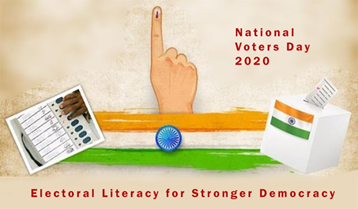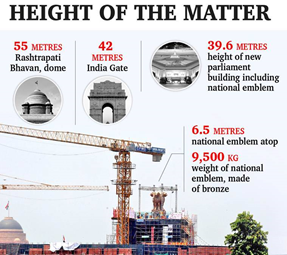Context
The Prime Minister unveiled India’s national emblem cast on the roof of the new Parliament building. However, the expression of the four lions of the national emblem, has been criticized alleging the government has violated the Constitution.

What is the National Emblem?
- The National Emblem is one of the most visible symbols of national identity and it is used as the seal of the Republic.
- It was adopted from the Lion Capital of one of the Ashoka Pillars on January 26, 1950.
- The symbol was adopted along with the motto 'Satyamev Jayate, taken from the Mundaka Upanishad and meaning 'truth always wins'.
- Badruddin Tyabji, a civil services officer and a freedom fighter, and his wife Surayya Tyabji proposed the usage of the Lion Capital for national symbol.
- When the Constitution was being drafted, Dinanath Bhargava was selected to design the National Emblem.
- Under the mentorship of Nandalal Bose, who designed the illustrations in the document, Bhargava sketched the Emblem on the first page of the Constitution.
|
How is the emblem structured?
- The emblem has four lions mounted back to back on a circular abacus, facing four different directions.
- They represent courage, pride, power and confidence.
- A circular abacus on which the lions stand is adorned with the engravings of a bull, a horse, and an elephant.
- Along with the lions, it is believed that the animals represent the four stages of Gautam Buddha's life.
- Lions indicate the stage of achieving enlightenment.
- The bull symbolises Taurus, the zodiac sign of Buddha.
- The elephant denotes his outset.
- The horse symbolises his ride after leaving the citadel where he gave his first sermon.
- The animals are separated by Ashok Chakras or Dharmachakras.
- The above-mentioned structure rests on an inverted lotus, which was chosen as the National Flower of India.
- However, it is not a part of the Emblem.
When was the National Emblem designed?
- The Lion Capital was erected in Sarnath 250 BC.
- Buddha gave his first sermon at Sarnath, Uttar Pradesh.
- It was excavated by Friedrich Oscar Oertel in 1905.
What is the political controversy around the new structure?
- Opposition parties say the national emblem unveiled looks 'ferocious' with its exposed fangs and different from the original depiction.
- India’s largest opposition party in Parliament (Indian National Congress (INC) said that the inscription 'Satyamev Jayate'is missing from the new structure atop the Parliament building.
- The government dismissed the criticism. "Sense of proportion & perspective. Beauty is famously regarded as lying in the eyes of the beholder. So is the case with calm & anger.
- The original Sarnath Emblem is 1.6 mtr high whereas the emblem on the top of the New Parliament Building is huge at 6.5 mtrs height.
- Sunil Deora, one of the two sculptors who designed the new statue, said that the perceived difference in the lion's demeanour is due to the scale of the new structure.

Does the central government have the right to change the design of the emblem?
- According to the Schedule of the State Emblem of India (Prohibition of Improper Use) Act (2005) “The State Emblem of India shall conform to the designs as set out in Appendix I or Appendix II” of the Act.
- However, the Act also mentions that the central government has the right “to do all such things (including the specification of design of the emblem and its use in the manner whatsoever) as the Central Government considers necessary or expedient for the exercise of the foregoing powers.”
- The central government, therefore, has the freedom to make changes to the designs of the emblem specified in the Act’s appendices.
- By making amendments to this act, the central government could legally change the national emblem entirely.

